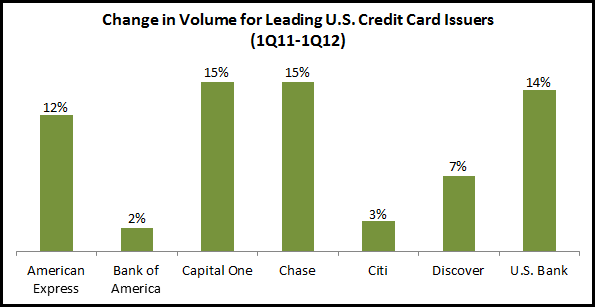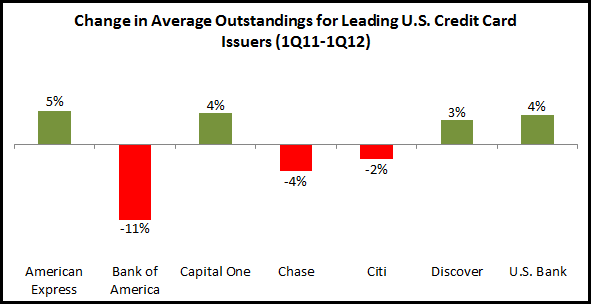An analysis of leading U.S. banks’ first quarter 2012 financial results reveals strong growth across the board in average commercial loan balances. This growth is largely due to the economic recovery following the Great Recession. Of the 14 banks studied, 11 recorded double-digit year-on-year increases in their portfolios.
This growth momentum has been maintained in recent quarters, with all banks reporting growth in average commercial loans between 4Q11 and 1Q12, and five having quarterly growth rates of more than 5%. As with the y/y growth, quarterly growth rates were strongest for PNC (+11%, boosted by the acquisition of RBC Bank) and Key (+7%).
Bank are further boosted by the fact that most reported commercial loan charge-off rates declines over the past year. However, increased competition for commercial loans has led to most banks reporting declines in loan yields over the past year. PNC’s yield on its commercial, financial industrial loans fell 53 basis points (bps) between 1Q11 and 1Q12. Other banks with substantial declines in commercial loan yields during this period include SunTrust (-47 bps), U.S. Bank (-42 bps), KeyBank (-55 bps) and BB&T (-31 bps).
Banks expect that commercial loans will continue to grow over the next few quarter (barring an unexpected economic crisis) and are pursuing a number of approaches to grow their commercial franchises.
- Targeting high-potential segments: A number of banks are focusing on particular industry segments. PNC’s overall commercial growth was driven by strong performance in lending to health care and financial services firms. Comerica’s energy portfolio grew by 62%, and its tech and life sciences portfolio increased by 38%. Banks are also targeting different business-size segments, such as middle markets (Chase grew its middle market loan portfolio 19% y/y).
- Building commercial deposits and cross-selling commercial clients: Capital One grew commercial deposits 15% y/y. And when banks bring in these new commercial deposit relationships, they then need to develop effective cross-sell programs. Huntington reported a 33% annualized increase in commercial deposits in 1Q12. It also claimed that 33% of commercial clients had 4+ products in 1Q12, up from 25% in 1Q11.
- Encouraging commercial clients to increase line utilization. Line utilization declined significantly following the financial crisis, as businesses retrenched. Many banks reported that utilization rates remained relatively low in the most recent quarter, but some banks are seeing some improvement. Regions reported a 45 basis point increase in utilization.



